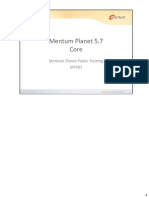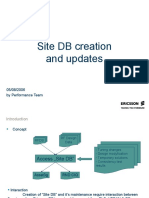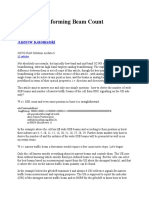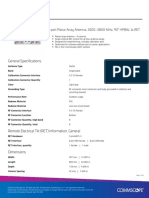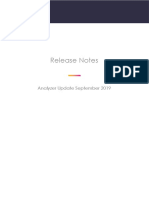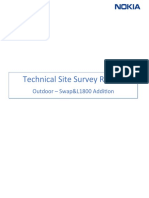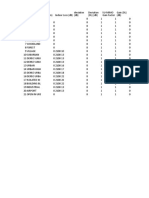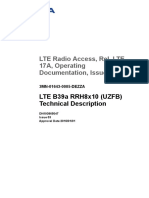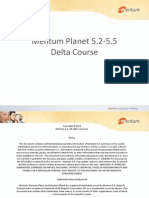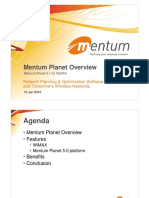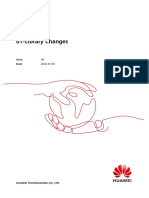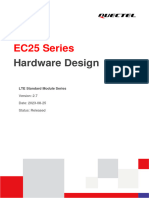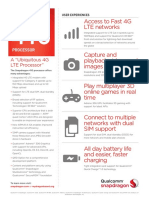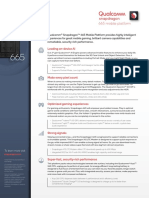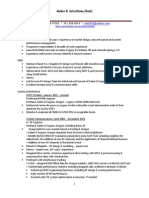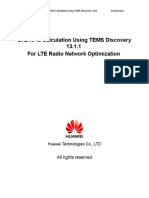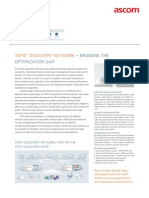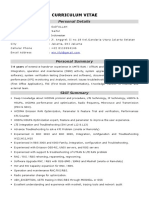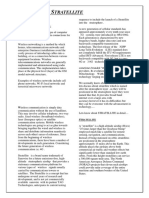Mentum Planet 5.
4
Gregory Donnard
Tuesday 6th 2012
�Agenda
Introduction Mentum Planet 5.3.2 General Features MapInfo 11 Antennas Propagation Radio Access Technologies Data Management Orange Labs Questions & Answers
2
�Mentum Planet 5.3.2
�Mentum Planet 5.3.2
Released on November the 30th of 2012 Maintenance release with a lot of features EV-DO Revision B
Multi-carrier EV-DO 64-QAM modulation
Multiple EV-DO revisions within the same Planet project Graphical Neighbour Plan Editor Miscellaneous
New neighbour plan merging algorithm Neighbour priorities defined in site editor
4
�General Features
�New Start Page
Allows to put relevant information for users
Upcoming webinars and training classes Information on Future product releases Product patches Etc.
Quick access to
Recent projects User guides Project creation, project opening
�Google Earth Export
New Google Earth export functionality No white background around exported grids Ability to export larger grids Ability to export sector, repeater, and antenna information
Google Earth Export
�MapInfo 11
�MapInfo 11
Ability to leverage 4 GB of RAM (vs. 2 GB of RAM before)
Big scalability enhancements
Open Street Map and Bing Roads layers
Free of charge
New table browser look & feel Enhanced table sorting
9
MapInfo Table Browser
�Bing Roads/Aerial/Hybrid & OSM
10
Bing Roads, Bing Aerial, Bing Hybrid and Open Street Map
�Antennas
�Antennas
Why a new antenna format? New antenna format
.pafx = .paf extended
Impact in Site Editor Antenna queries Antenna server Antenna synchronization Antenna Optimization Constraints
12
�Why a new antenna format?
More and more Mentum Planet customers asking for the support of advanced antennas in Mentum Planet
E.g. Multi-beam antennas, Quad-pole antennas, multisector configurations
Multiple requests to have an antenna format that is a representation of physical antennas
E.g. modelling of antenna ports, e-controllers, etc.
Mentum hence decided to introduce a new antenna format in Mentum Planet 5.4
Format: .pafx
13
�Dual-Beam Antenna
Kathrein Dual Beam Antenna 80010606
14
�Mentum Planet 5.4 Antenna Format
Prior to Mentum Planet 5.4
Antenna format: .paf (version 1.0)
Mentum Planet 5.4
Antenna format: .pafx
A given .pafx antenna file is a compressed version of a .paf version 2.0 file.
15
�Mentum Planet 5.4 Antennas
Ability to define antenna ports Support for dual, cross, quad-pole antennas Multi-band antennas Support for electrical controllers Support for Remote Control Unit Support for 3-way antennas
16
Mentum Planet 5.4 Antenna Editor
�3D Antenna Viewer
3D Antenna Viewer
17
�Site Editor
Ability to select downlink and uplink ports in site editor Antenna algorithms (e.g. diversity, spatial multiplexing) based on selected downlink and uplink ports
Mentum Planet 5.4 Site Editor
18
�Antenna Queries & Antenna Server
Antenna Queries and antenna server adapted to work with new antenna format Ability to filter antennas based on
Frequency bands Number of ports Beamwidth Polarization Boresight Gain Etc.
19
Antenna Server Filters
�Valorisation of Antenna Server
The Antenna Server is a very powerful feature More visibility in mP 5.4
Download option when right-clicking on Antennas node Download option from Data menu
Download Option from Antennas Node
20
�Antenna Synchronization
Three dual-beam antennas to be used by six sectors Dual-beam antennas physically linked to each other Important to consider such synchronization in Radio Planning and Automatic Cell Planning tool
21
Dual-Beam Antenna 6-Sector Configuration
�Antenna Optimization Constraints
Ability to define azimuth constraints between pairs of antenna systems
Site Editor Antenna Optimization Constraints
22
�Update Antenna Assignments
If users update antennas in a rather radical way (e.g. port or deletion), antenna assignments become invalid Users are then prompted to Update antenna assignments Update of Sites, Surveys, and Subscriber editor
23
Update Assignments from Antennas Node
�Antennas - Miscellaneous
Support for polarization in antenna definition files
24
�Propagation
�Berg Antenna Masking
Antenna masking used in Mentum Cell Planner Addition of co-pol and cross-pol patterns for crosspolarized antennas Gaussian Filtering
To attenuate unrealistic strong Nulls
Enhanced interpolation algorithm
26
�Propagation Signatures
Operators typically tune propagation models periodically based on CW measurements Tuned propagation models are then to be used by RF engineers for accurate predictions The challenge is to assess which propagation model is the most appropriate one This is rather time-consuming process, and also quite often leads to incorrect model assignments Another challenge faced by operators is that measurements are not available in all markets, hence the will to reuse models tuned in one region to another region of similar environment
27
�What Are Propagation Signatures?
Propagation Signatures represent the environment in which propagation models are valid They can be created from sectors or from surveys (where the transmitter configuration is the information that is used, not the measurements)
Transmitter Configuration
Clutter
Elevation
Clutter Heights
Propagation Signature
28
�Use of Propagation Signatures
Propagation Signatures can be used for faster and more accurate propagation model assignments Using sectors tuned in the same market, or tuned in another market
Measurements Market A
Tuned & Signed Models Market A
Model Assignments Markets A, B, etc.
29
�Propagation Signatures Delivery
Delivery of Planet extensions for Planet 5.4
One extension to create Propagation Signatures One extension to compare Propagation Signatures and to perform fast and optimal model assignments
Integration in Mentum Planet 5.5. Mentums strategy
Creation of Propagation Signatures (paid services) to be done by Mentum only, and potentially selected companies Mentum Planet users can use for free Signed propagation models to assign propagation models
30
�Point to Point Profile Tool
P2P tool to support
3D buildings data Clutter Height grids
Point-to-Point Profile Tool
31
�Calculation & Output Resolution
Planet General Model
Ability to define calculation resolution Ability to define output resolution
Predict 4
Ability to define output resolution
Planet General Model Editor
32
�Radio Access Technologies
�Prediction Cache
Replacement of Prediction View by Prediction Cache for every tool in Mentum Planet Faster creation of the Cache
Cache limited to analysis area Partial update supported
Faster creation of analyses layers and Monte Carlo simulations Smaller disk space required because tiles are compressed Generation of the Cache integrated with processes Support for multi-resolution, split sectors, etc.
34
�HSPA Rel. 9 and Rel. 10
Support for MultiCarrier data rate (DualCarrier data rate only HSPA Rel. 8)
Number of carriers that can be aggregated depends on UE Terminal Categories
Support for Dual-Carrier HSUPA
Supported by some UE Terminal Categories only
35
Site Editor - HSPA parameters
�LTE TDD de-synchronization
Base station to base station interference matrix for sectors beyond a certain distance (e.g. 21.4 km) Minimum distance controlled by special subframe configuration
LTE TDD Special Subframe Configurations
Distant base station seen as an interferer
36
36
�LTE TDD de-synchronization
TDD de-synchronization IMs in Mentum Planet
Based on Point to Point predictions Computation of Percentage of Uplink frame interfered Computation of Received Power
Ability to apply interference levels to sectors
Accounting for sector-carrier loads
Network analyses & Monte Carlo simulations to leverage TDD interference
Defined on a per sector-carrier basis Added noise at the BTS level
37
�LTE Antenna Algorithms
Ability to define different diversity and multiplexing gains:
For the Downlink and the Uplink For different channel models (e.g. Pedestrian 3 km/h)
Leveraged in Network Analyses and Monte Carlo simulations
LTE Antenna Algorithms
38
�Preamble Radio Access CHannel
PRACH Channel used for initial network access or when in handover PRACH also use to achieve uplink synchronization PRACH cannot carry data => strict overhead
LTE Channels
39
�PRACH Overhead
PRACH channel multiplexed in time and frequency with PUCCH and PUSCH Users can define
Preamble format, which defines the size of a PRACH resource in time domain Number of resources per frame in the time domain
Preamble format
40
�PRACH Root Sequence Planning
Each LTE cell needs 64 Preambles
Preambles are generated from ZadoffChu sequences Each sequence can generate X Preambles, X being defined by the cells Cyclic Shift (Ncs)
Not Supported in mP 5.4
Dimensioning of Ncs Automated planning of Zadoff-Chu sequences
LTE Sector Configuration
41
�PRACH Root Sequence Display
Ability to view the reuse of PRACH root sequences Along with neighbour relationships Optionally displayed on sectors serving area
PRACH Root Sequence Display Tool
42
�Heterogeneous Networks
Different transmission powers for macro and pico cells. Impact on cell selection
The cell that serves a given UE is not always the cell that offers the strongest RSRP
New option in Mentum Planet 5.4 to consider Uplink coverage when selecting server
43
Cell Selection in a Heterogeneous Network
�LTE Hard Handover Gain
Quick cell re-selection when one sector experiences down fading, which results in so-called Hard Handover Gain In link budget, Hard HO gain modelled as constant gain (in dB) Advanced modelling in Planet based on signal correlation
44
LTE Analysis Hard Handover Gain
�LTE Other Features (1)
Support for LTE sub-bands
Also available for WiMAX TDD Allows users to define exact frequencies for carriers
Support for multi-band analyses and Monte Carlo simulations
More important now that operators start having multiple LTE carriers, and those carriers are quite often in different bands
Mobile Speeds replaced by Channel Models
Alignment with 3GPP standard terminology
45
�LTE Other Features (2)
Ability to account for fading when computing multiplexing gains PCID planning: ability to have assignments follow the same order as azimuths Carrier aggregation Automatic computation of the optimal number of RBs per user in LTE network analyses
The optimal number of Resource Blocks is the one that leads to the highest data rate
46
�LTE Other Features (2)
Support for carrier preferences
To enable sequential or balanced loading strategies
PBCH CINR layer Fixed subscriber analyses ability to force server assignments (as opposed to always assuming that the most appropriate cell is the server)
Available for WiMAX TDD as well
47
�Technology - Miscellaneous
Ability to define larger carrier bandwidth for TDMA/FDMA technology Uplink Eb/No layer for WCDMA and Cdma2000 Support for iDEN
Full port of Mentum Planet 4.5 functionalities
Support for Erlang C table in Traffic Analysis and Dimensioning Tool Generation of up to 40th server for WiMAX
48
�Data Management
�Custom Reports
Ability to quickly create custom reports Multiple report types Possibility to generate reports for multiple templates at once Output formats
MapInfo table Report Preview dialog Excel Csv
50
Report Template Wizard
�Tabular Editor Advanced Filtering
Advanced Filtering option available in Tabular Editor Similar functionalities as Excel Example
Antenna heights between 20 and 30 meters above ground
Tabular Editor Advanced Filtering
51
�Data Management Miscellaneous
Ability to have multiple Base Stations of the same technology on the same site Ability to have Mentum Planet 5.4 co-installed with previous Mentum Planet 5.X versions Ability to import AOD files for WCDMA/HSPA Sector Display Schemes to support repeaters Ability to import surveys defined as .xlsx files Integration of TEMS Route Reader 7.0 Integration with Ellipse 8.1
52
�Data Management Miscellaneous
Migration of mCP GSM projects Migration of mCP 10.1 projects New About dialog for Mentum Planet and Planet migrator Ability to edit link configuration within site editor without closing site editor Integration of L-Band restrictions tool Easier way to move sites on the map
53
�Orange Labs
�Universal Model
Multi-processed predictions (as opposed to multithreaded within a single process in Mentum Planet 5.3)
Ability to generate larger predictions Faster predictions
Enhanced modelling with Forest polygon Enhanced Horizontal propagation modelling option available with raster Geodata Support for units defined in imperial system
55
�Forest Modelling
In Mentum Planet 5.3, Forest and Building polygons are treated in a very similar manner
Diffraction is treated the same way on Buildings or Forest
In Mentum Planet 5.4, option to
Ignore Forest polygons in diffraction calculations Account for a penetration loss proportional to the length of the Forest polygon
The only differences are
Forest polygons are not accounted for when building street graph No in-building penetration applied for Forest polygons
56
�Renaissance
Re-introduction of evaluation module
Update o the TDMA API to allow Orange Labs to reintroduce the evaluation module
57
�Questions & Answers
Mentum
Defining your wireless network
